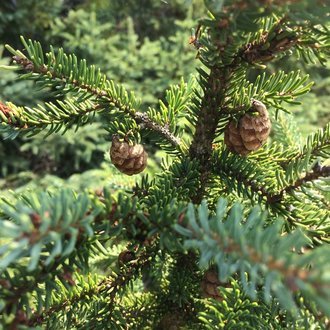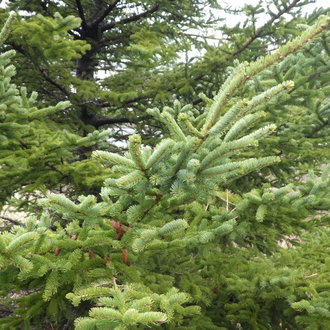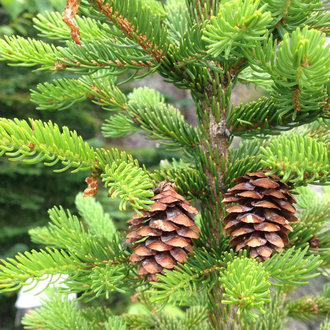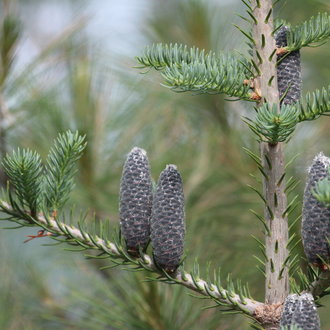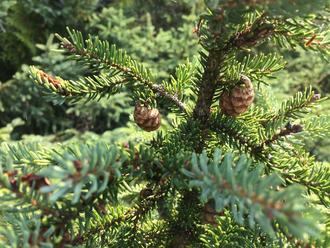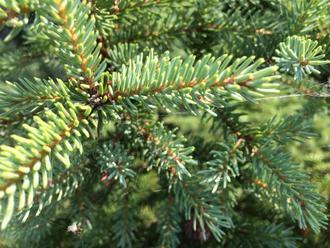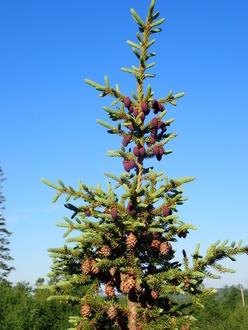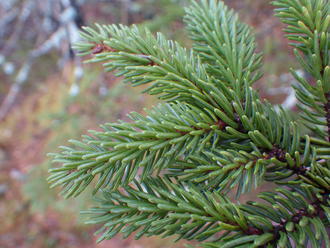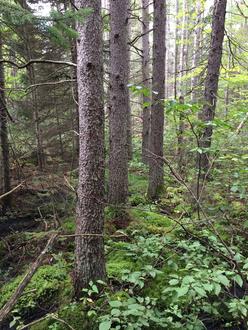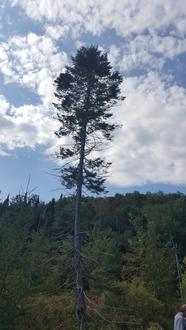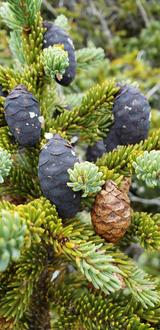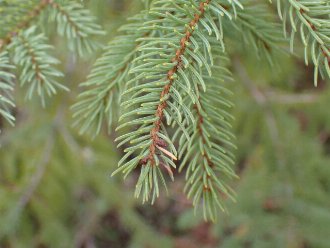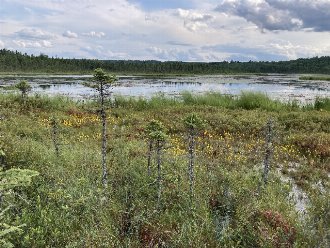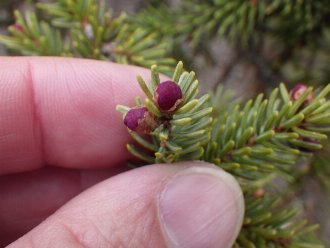Black Spruce (Picea mariana )
↑Summary
A conifer with a northerly distribution, native to North America; found on acidic soils, often on poorly-drained sites, often with stunted growth.
↑Range - Expand
| Legend | Color |
| Native | |
| Native or Not Present |
This map is based on our research. We have checked its accuracy to Level 3 ecoregions. Although this plant occurs somewhere in each of these regions, it may only occur in a small part of some or all of them.
The Canadian portion of this map was built using range maps from the FEIS and Silvics manual, with some supplemental data from iNaturalist records, and written descriptions of the flora of various ecoregions of the arctic.
↑Similar Plants
↑Habitat
Black spruce is a habitat generalist, found on a wide range of sites, but usually only on ones where other species cannot thrive.
Common on poorly drained sites. In the south of its range, it is mostly restricted to acidic peatlands and bogs that form in depressions, and transitional sites on the border of these areas. In the north, it also occurs on sites that are poorly drained due to permafrost. It becomes especially dominant near the tree line, where it switches to growing in a matted form.
It is also found on dry upland sites, especially north-facing slopes with a gentle gradient. It tends to occupy sites where white spruce is absent.
It is rare to absent in coastal areas where exposed to salt spray.
Although it can grow in a variety of soil textures, it is mostly restricted to acidic soils due to a combination of its range, and being outcompeted by other vegetation on other soils.
↑Life Cycle
In most regions, black spruce primarily establishes from seed following fires, usually not immediately, but within 10 years of a major fire.
Seedlings can grow in a variety of conditions. Although they are shade-tolerant, they do not compete favorably with the lusher vegetation on richer sites. Initial growth is slow; seedlings rarely reach more than 1 inch (2.5cm) in height in their first year, and are typically only 3-5 inches (8-13cm) tall at three years. Growth can be further stunted by the harsh conditions in which this species grows. When it co-occurs with other woody species, it tends to grow more slowly than them. Trees often grow so slowly that growth rings are hard to observe, and among mature trees, height and age are not well-correlated.
Seed production begins around 10 years of age on favorable sites, but most trees produce minimal seed until 30 years or older. Different researchers have observed seed production peaking between 50 and 150 years, or between 100 and 200 years, after which it declines somewhat. There is some seed production every year, with bumper crops produced every 2-4 years.
The cones are semiserotinous, meaning that some seeds will be released when the cones are mature, but other cones remain on the tree, closed, sometimes for years, and are only released in response to fire or prolonged hot weather. Black spruce stands have a significant seed bank stored in cones on the tree (including on dead trees), but there is no seed bank in the soil.
Seeds are lightweight and winged, and are distirbuted primarily by wind. Once dispersed, seeds only stay viable for less than a year. Fire triggers a gradual release of seeds, with some seeds being released immediately but others remaining in the cones are released over subsequent years, mostly 1-2 years after a fire, but some substantially later. Hot, dry weather also leads to opening of cones, although this process is much slower than fire. Cold, wet weather, on the other hand, tends to cause cones to remain closed longer.
Seeds germinate best on mineral soil or charred organic matter, and also germinate well in the moist sphagnum moss that dominates bogs, but can germinate in a variety of other substrates. Germination requires moisture, and heavy layers of ash or other hydrophobic soil conditions inhibit germination; this factor inhibits black spruce establishment shortly after a fire.
In addition to reproducing by seed, trees can also reproduced vegetatively, primarily by layering of lower branches. Layering is most common in swamps and bogs with abundant moisture and organic soils, and also at the tree line (both at high elevations and in the far north) where this tree's form tends to shift to a sprawling mat that spreads horizontally more than growing upright. Trees can also sprout from roots, and in some areas root sprouting is more important than layering. Close to the tree line, production of viable seeds is minimal, and this species relies more on vegetative reproduction.
The successional status of this species is variable on different sites. Where it occurs together with jack pine (Pinus banksiana), the jack pine tends to recolonize quicker after fires and initially dominate, being replaced later by black spruce. In areas that burn less frequently, especially in the south of its range, it can be replaced by hardwoods and other conifers. In bogs, especially those filled with peat, it is often a stable dominant species. In some boreal forests, it can share dominance with red spruce and balsam fir in a stable climax. Black spruce tends to be replaced on richer sites able to support faster-growing and more shade-tolerant vegetation, and tends to be part of the climax community on harsher sites such as bogs and other poorly-drained sites, and areas closer to the tree line, including areas in the north with extensive permafrost.
↑Faunal Associations
The Spruce budworm (Choristoneura sp.) eats this and other spruce and fir species, but tends to defoliate white spruce, balsam fir, and red spruce more than black spruce, thus indirectly benefitting this species.
Larger mammals, including both wild animals and livestock, rarely browse on black spruce, typically only eating it when other food is scarce. However snowshoe hares (Lepus americanus) browse on this species more heavily.
The seeds are eaten by numerous birds, including chickadees, nuthatches, crossbills, and pine siskin, and numerous mammals, including red squirrels, mice, voles, shrews, and chipmunks. The seeds are smaller and contain fewer calories than other spruce seeds, especially the larger white spruce seeds.
Black spruce has greater wildlife value in terms of cover, as it often provides cover in area where other vegetation is sparse or absent. Moose use spruce for bedding in summer, and spruce grouse uses black spruce extensively for cover. Smaller birds, including ruby-crowned kinglet, magnolia warbler, and Cape May warbler, commonly use black spruce as a nesting site.
↑Related Plants
Black spruce is most closely related to red spruce (Picea rubens), with which it hybridizes relatively frequently, particularly in eastern Canada. Such hybrids are fertile, and there are intergrades and gene flow between the two species.
Black spruce is slightly less closely related to white spruce (Picea glauca); although hybrids have been reported in Minnesota.
↑Links & External Resources
• Black Spruce | The Wood Database (About This Site)
• Black Spruce | Fire Effects Information System (FEIS) (About This Site)
• Picea mariana (Black Spruce) | USDA PLANTS Database (About This Site)
• Picea mariana | Go Botany (About This Site)
• Black Spruce | iNaturalist (About This Site)
• Black Spruce | Virginia Tech Dendrology Factsheets (About This Site)
• Black Spruce | Silvics of North America (About This Site)
• Picea mariana | Biota of North America Project (BONAP) (About This Site)



